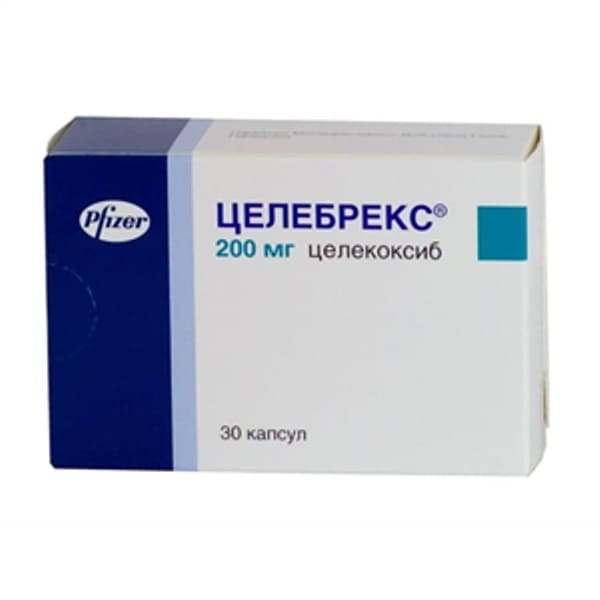You have no items in your shopping cart.

Sku:
Dosage form
Capsules opaque, white or almost white, hard gelatin, white markings, yellow stripes: "200" on one part and the "7767" - on the other side of the pod.
Composition
1 caps.
celecoxib 200 mg
Excipients: lactose monohydrate 49.8 mg, sodium lauryl sulfate 8.1 mg, povidone K30 6.7 mg, croscarmellose sodium 2.7 mg magnesium stearate 2.7 mg.
The composition of the shell capsules: gelatin, about 58.3 mg, titanium dioxide about 1.7 mg.
The composition of yellow ink (SB-3002): shellac, ethanol, isopropanol, butanol, propylene glycol, aqueous ammonia, dye iron oxide yellow (E172).
Pharmacological action
NSAIDs. Celecoxib has anti-inflammatory, analgesic and antipyretic action by blocking the formation of inflammatory prostaglandins is mainly due to the inhibition of COX-2. Induction of COX-2 occurs in response to the inflammatory process and leads to the synthesis and accumulation of prostaglandins, particularly prostaglandin E2, thus there is increasing incidence of inflammation (swelling and pain).At therapeutic doses in humans, celecoxib does not significantly inhibit COX-1 and has no effect on prostaglandins that are synthesized by activation of COX-1 and has no effect on the normal physiological processes associated with COX-1 and flowing in the tissues, primarily in tissues of the stomach, intestines and platelets.
The impact on renal function. Celecoxib reduces the urinary excretion of prostaglandin E2 and 6-keto-prostaglandin F1 (metabolite of prostacyclin), but no effect on serum thromboxane B2 and the urinary excretion of 11-dehydro-thromboxane B2, a thromboxane metabolite (both products of COX-1). Celecoxib does not cause a reduction of glomerular filtration rate in elderly patients and patients with chronic renal failure, and transiently reduces the excretion of sodium.
Patients with arthritis of the observed incidence of peripheral edema, hypertension, and heart failure is comparable to that in patients receiving non-selective COX inhibitors, which have inhibitory activity against COX-1 and COX-2.
Testimony
— symptomatic treatment of osteoarthritis rheumatoid arthritis and ankylosing spondylitis;
— pain: back pain, musculoskeletal, postoperative and other (of comparable intensity) types of pain);
— treatment of primary dysmenorrhea.
Contraindications
— bronchial asthma, urticaria or allergic reactions after taking acetylsalicylic acid or other NSAIDs, including other COX-2 inhibitors;
— status post coronary artery bypass surgery;
— a peptic ulcer in the acute phase;
— gastrointestinal bleeding;
inflammatory bowel disease;
— heart failure (II-IV functional class NYHA classification);
— clinically confirmed CHD;
— peripheral artery disease and cerebrovascular disease severe;
— severe liver failure (no experience of application);
— renal failure severe (no experience of application);
— pregnancy;
— lactation (breastfeeding);
— the age 18 years (no experience of application);
— hypersensitivity to the drug component;
— hypersensitivity to sulphonamides.
Drug interactions
In vitro studies showed that celecoxib, although not a substrate of CYP2D6, but inhibits its activity. Therefore there is a possibility of drug interaction in vivo preparations, metabolism of which is associated with the cytochrome CYP2D6.
While concurrent use with warfarin and other anticoagulants may increase prothrombin time.
Patients, receiving fluconazole (inhibitor of CYP2C9), celecoxib should be administered in the lowest recommended dose, ketoconazole (inhibitor of CYP3A4) has no clinically significant effect on the metabolism celecoxib.
The inhibition of prostaglandin synthesis can reduce the effect of ACE inhibitors and antagonists of angiotensin II. This interaction should be taken into consideration when assigning celecoxib in conjunction with ACE inhibitors/antagonists of angiotensin II. However, there has been no significant pharmacodynamic interaction with lisinopril in regards to the effect on HELL.